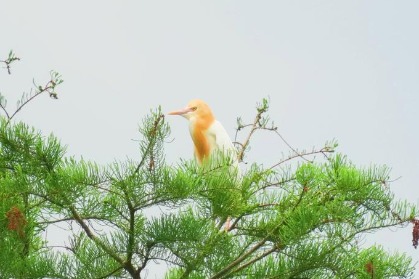Foraging adds natural flavor to fresh dishes
With arrival of spring, Beijingers head to suburbs to gather wild vegetables


A taste of spring
"We started our foraging season in mid-March," said a woman surnamed Zhang, who works with a State-owned company in Beijing and chose not to tell China Daily her full name.
Along with her husband and their sixth-grade son, she shares a passion for hiking and often explores the hills on the outskirts during weekends. Zhang keeps an eye out for any signs of plant growth while they are on their hikes.
"In earlier spring, I started searching for jicai (shepherd's purse) in the wildness," she said. "For people from South China like us, it is one of our favorite wild vegetables and also one of the earliest plants to sprout in Beijing. The thought of jicai dumpling soup makes my mouth water."
She said that she and her husband are not real foragers. The primary allure of foraging for them is the opportunity to enjoy seasonal vegetables. "Spring vegetables are fresh and nutritious," Zhang said.
She enjoys serving wild vegetable dishes, which offer a "distinctive taste of spring". The real foragers of the family are her mother and parents-in-law. The three senior members of the family share a hobby — collecting wild vegetables.
On a Saturday in March, the couple drove their parents to "our secret valley" and set the seniors free. The couple foraged for a while and then prepared their lunch at their camp site. "Foraging can be quite demanding, and I tend to tire quickly," Zhang said. "But our parents are truly adept at identifying and collecting wild vegetables. In just one day, they managed to harvest more than 10 kilograms of jicai."
After the outing, the family can enjoy jicai dumpling soup for a few meals, she said.
In early April, shepherd's purse, a flowering plant in the mustard family that grows all over the world and is one of the most common wildflowers on Earth, started flowering. The wild vegetable's leaves grew too ripe and firm to eat. Zhang turned her attention to Chinese violet cress, which is native to northern and southeastern China and the Democratic People's Republic of Korea.
She had never treated it as a wild vegetable until a friend told her that it is actually a healthy vegetable. The family foraged Chinese violet cress during a weekend last month, and didn't have to drive far from downtown Beijing.
"The flowers are everywhere," Zhang said. "We carefully selected tender buds and leaves from the upper parts of the plants along the Wenyu River bank. Following a rainfall, more new leaves and buds will sprout from the plants."
At home, Zhang briefly blanched the wild vegetable in boiling water before stir-frying it for a minute or two and seasoning it with soy sauce. "The flavor is simply delightful, a little reminiscent of tender pea shoots," she said.
- Foraging adds natural flavor to fresh dishes
- China trip leaves India media impressed
- Setting ropes and mapping crevasses, brave summiteer keeps fellow valiants safe
- Success for 'silver-haired' tourism trains
- China's space station delivers new samples for research
- Escape the city, embrace shores and slow living





































